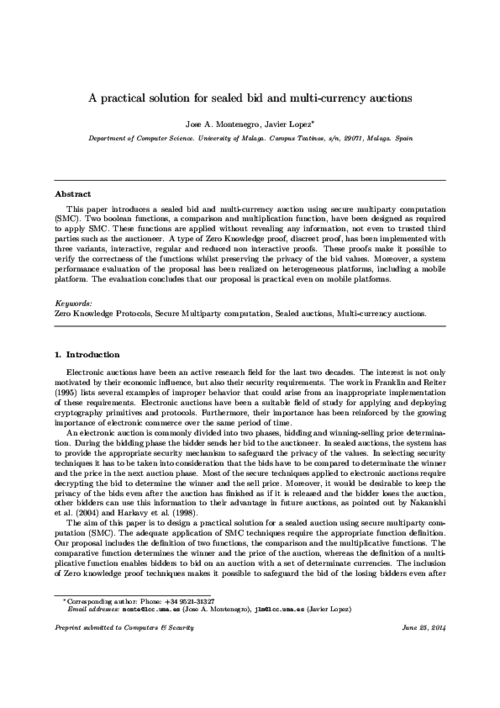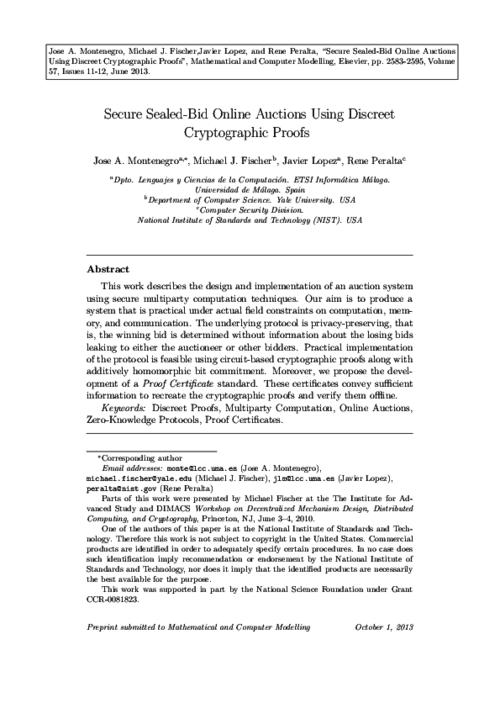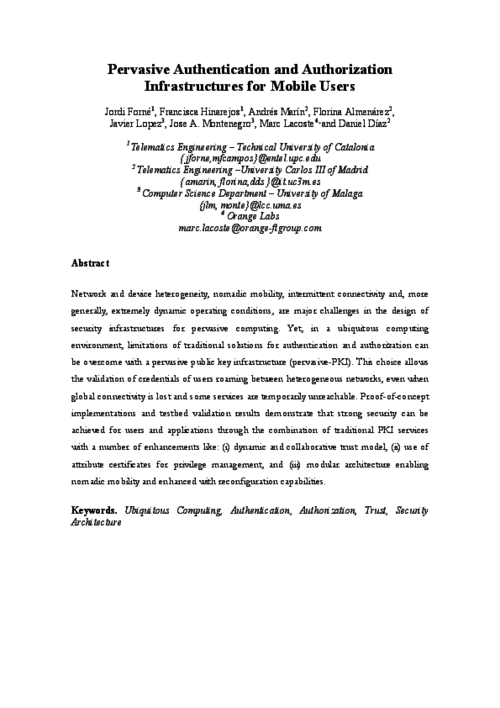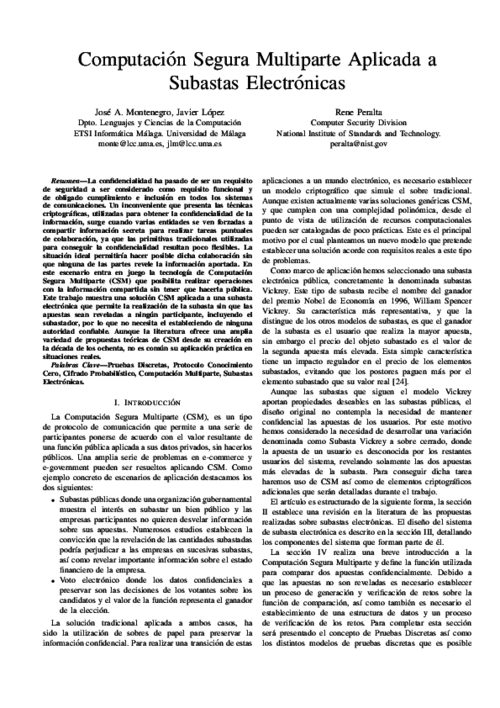Jose A. Montenegro

ASSOCIATE Professor
Computer Science Department, University of Malaga
Campus de Teatinos s/n,29071 – Malaga (Spain)
Phone: +34 952 132 808 | Fax: +34 952 131 397
E-mail: jmmontes@uma.es
GitHub https://github.com/montenegro-montes/
Orcid https://orcid.org/0000-0001-6967-0801
Domain of interest and research
- AI Security
Education
- July 2007 – PhD in Computer Science – University of Malaga
- 2005-2007 Master in Business Administration (MBA). National Distance Education University. UNED.
- 2001 – Master in Computer Science. University of Malaga
- 1994 – Bachelor in Computer Science. University of Malaga
Relevant publications
Jose A. Montenegro, Javier Lopez
A practical solution for sealed bid and multi-currency auctions Journal Article
In: Computers & Security, vol. 45, pp. 186-198, 2014, ISSN: 0167-4048.
@article{MoLo15,
title = {A practical solution for sealed bid and multi-currency auctions},
author = {Jose A. Montenegro and Javier Lopez},
url = {/wp-content/papers/MoLo15.pdf},
doi = {10.1016/j.cose.2014.06.004},
issn = {0167-4048},
year = {2014},
date = {2014-09-01},
urldate = {2014-09-01},
journal = {Computers \& Security},
volume = {45},
pages = {186-198},
publisher = {Elsevier},
abstract = {This paper introduces a sealed bid and underlinemulti-currency auction using secure multiparty computation (underlineSMC).
Two boolean functions, a comparison and multiplication function, have been designed as required to apply underlineSMC. These functions are applied without revealing any information, not even to trusted third parties such as the auctioneer. A type of Zero Knowledge proof, discreet proof, has been implemented with three variants, interactive, regular and reduced non interactive proofs. These proofs make it possible to verify the correctness of the functions whilst preserving the privacy of the bid values. Moreover, a system performance evaluation of the proposal has been realized on heterogeneous platforms, including a mobile platform. The evaluation concludes that our proposal is practical even on mobile platforms.},
keywords = {},
pubstate = {published},
tppubtype = {article}
}
Two boolean functions, a comparison and multiplication function, have been designed as required to apply underlineSMC. These functions are applied without revealing any information, not even to trusted third parties such as the auctioneer. A type of Zero Knowledge proof, discreet proof, has been implemented with three variants, interactive, regular and reduced non interactive proofs. These proofs make it possible to verify the correctness of the functions whilst preserving the privacy of the bid values. Moreover, a system performance evaluation of the proposal has been realized on heterogeneous platforms, including a mobile platform. The evaluation concludes that our proposal is practical even on mobile platforms.
Jose A. Montenegro, Michael J. Fischer, Javier Lopez, Rene Peralta
Secure sealed-bid online auctions using discreet cryptographic proofs Journal Article
In: Mathematical and Computer Modelling, vol. 57, pp. 2583–2595, 2013, ISSN: 0895-7177.
@article{MFLR13,
title = {Secure sealed-bid online auctions using discreet cryptographic proofs},
author = {Jose A. Montenegro and Michael J. Fischer and Javier Lopez and Rene Peralta},
url = {/wp-content/papers/MFLR13.pdf},
doi = {10.1016/j.mcm.2011.07.027},
issn = {0895-7177},
year = {2013},
date = {2013-06-01},
urldate = {2013-06-01},
journal = {Mathematical and Computer Modelling},
volume = {57},
pages = {2583\textendash2595},
publisher = {Elsevier},
abstract = {This work describes the design and implementation of an auction system using secure multiparty computation techniques. Our aim is to produce a system that is practical under actual field constraints on computation, memory, and communication. The underlying protocol is privacy-preserving, that is, the winning bid is determined without information about the losing bids leaking to either the auctioneer or other bidders. Practical implementation of the protocol is feasible using circuit-based cryptographic proofs along with additively homomorphic bit commitment. Moreover, we propose the development of a emphProof Certificate standard. These certificates convey sufficient information to recreate the cryptographic proofs and verify them offline.},
keywords = {},
pubstate = {published},
tppubtype = {article}
}
Jordi Forne, M. Francisca Hinarejos, Andres Marin, Florina Almenarez, Javier Lopez, Jose A. Montenegro, Marc Lacoste, Daniel Diaz
Pervasive Authentication and Authorization Infrastructures for Mobile Users Journal Article
In: Computer and Security, vol. 29, pp. 501-514, 2010, ISSN: 0167-4048.
@article{JordiForne2009,
title = {Pervasive Authentication and Authorization Infrastructures for Mobile Users},
author = {Jordi Forne and M. Francisca Hinarejos and Andres Marin and Florina Almenarez and Javier Lopez and Jose A. Montenegro and Marc Lacoste and Daniel Diaz},
url = {/wp-content/papers/JordiForne2009.pdf},
doi = {10.1016/j.cose.2009.09.001},
issn = {0167-4048},
year = {2010},
date = {2010-01-01},
urldate = {2010-01-01},
journal = {Computer and Security},
volume = {29},
pages = {501-514},
publisher = {elsevier},
abstract = {Network and device heterogeneity, nomadic mobility, intermittent connectivity and, more generally, extremely dynamic operating conditions, are major challenges in the design of security infrastructures for pervasive computing. Yet, in a ubiquitous computing environment, limitations of traditional solutions for authentication and authorization can be overcome with a pervasive public key infrastructure (pervasive-PKI). This choice allows the validation of credentials of users roaming between heterogeneous networks, even when global connectivity is lost and some services are temporarily unreachable. Proof-of-concept implementations and testbed validation results demonstrate that strong security can be achieved for users and applications through the combination of traditional PKI services with a number of enhancements like: (i) dynamic and collaborative trust model, (ii) use of attribute certificates for privilege management, and (iii) modular architecture enabling nomadic mobility and enhanced with reconfiguration capabilities.},
keywords = {},
pubstate = {published},
tppubtype = {article}
}
Jose A. Montenegro, Javier Lopez, Rene Peralta
Computacion Segura Multiparte Aplicada a Subastas Electrónicas Proceedings Article
In: IX Jornadas de Ingeniería Telemenatica (JITEL 2010), 2010.
@inproceedings{JoseA.Montenegro2010,
title = {Computacion Segura Multiparte Aplicada a Subastas Electr\'{o}nicas},
author = {Jose A. Montenegro and Javier Lopez and Rene Peralta},
url = {/wp-content/papers/JoseA.Montenegro2010.pdf},
year = {2010},
date = {2010-00-01},
urldate = {2010-00-01},
booktitle = {IX Jornadas de Ingenier\'{i}a Telemenatica (JITEL 2010)},
abstract = {La confidencialidad ha pasado de ser un requisito de seguridad a ser considerado como requisito funcional y de obligado cumplimiento e inclusi\'{o}n en todos los sistemas de comunicaciones. Un inconveniente que presenta las t\'{e}cnicas criptogr\'{a}ficas, utilizadas para obtener la confidencialidad de la informaci\'{o}n, surge cuando varias entidades se ven forzadas a compartir informaci\'{o}n secreta para realizar tareas puntuales de colaboraci\'{o}n, ya que las primitivas tradicionales utilizadas para conseguir la confidencialidad resultan poco flexibles. La situaci\'{o}n ideal permitir\'{i}a hacer posible dicha colaboraci\'{o}n sin que ninguna de las partes revele la informaci\'{o}n aportada. En este escenario entra en juego la tecnolog\'{i}a de Computaci\'{o}n Segura Multiparte (CSM) que posibilita realizar operaciones con la informaci\'{o}n compartida sin tener que hacerla p\'{u}blica. Este trabajo muestra una soluci\'{o}n CSM aplicada a una subasta electr\'{o}nica que permite la realizaci\'{o}n de la subasta sin que las apuestas sean reveladas a ning\'{u}n participante, incluyendo el subastador, por lo que no necesita el estableciendo de ninguna autoridad confiable. Aunque la literatura ofrece una amplia variedad de propuestas te\'{o}ricas de CSM desde su creaci\'{o}n en la d\'{e}cada de los ochenta, no es com\'{u}n su aplicacion pr\'{a}ctica en situaciones reales.},
keywords = {},
pubstate = {published},
tppubtype = {inproceedings}
}
Attended courses and seminars
- 2007- 2008 – PostDoctoral Fulbright Grant- Computer Security Division (ITL) NIST
- Jul. 2002 – Fifth European Intensive Programme on Information and Communication Technologies Security (IPICS 2002) 8-19 July Karlovassi, Samos Island, Greece
Scientific Activities
- Program committee member:
- 1st International Conference on Cloud Computing and Services Science, CLOSER 2011, Noordwijkerhout, The Netherlands 7-9 May 2011
- 6th International Conference on P2P, Parallel, Grid, Cloud and Internet Computing (3PGCIC 2011), Barcelona, Spain. October 26-28, 2011.
- The 2nd International Conference on Cloud Computing, CloudCom 2010, November 30- December 3, 2010, Indianapolis,USA
- 13th Conference on Information Security and Cryptology ICISC’10, December 1-3, 2010, Seoul, Korea
The First International Workshop on Cloud Computing Interoperability and Services (InterCloud 2010), June 28 – July 2, 2010 Caen, Normandy, France - 12th Conference on Information Security and Cryptology ICISC’09, December 2-4, 2009, Seoul, Korea
2nd International Workshop on Computational Intelligence in Security for Information Systems CISIS’09, September 23-26, 2009, Burgos, Spain - The 1st International Conference on Cloud Computing, CloudCom 2009, December 1-4, 2009, Beijing, China
Presentations
- Secure Sealed-Bid Online Auctions Using Discreet Cryptographic Proofs, 2008 NIST Sigma Xi Postdoctoral Poster Presentation





